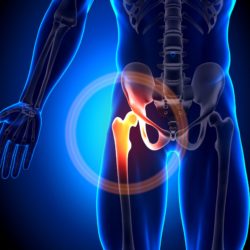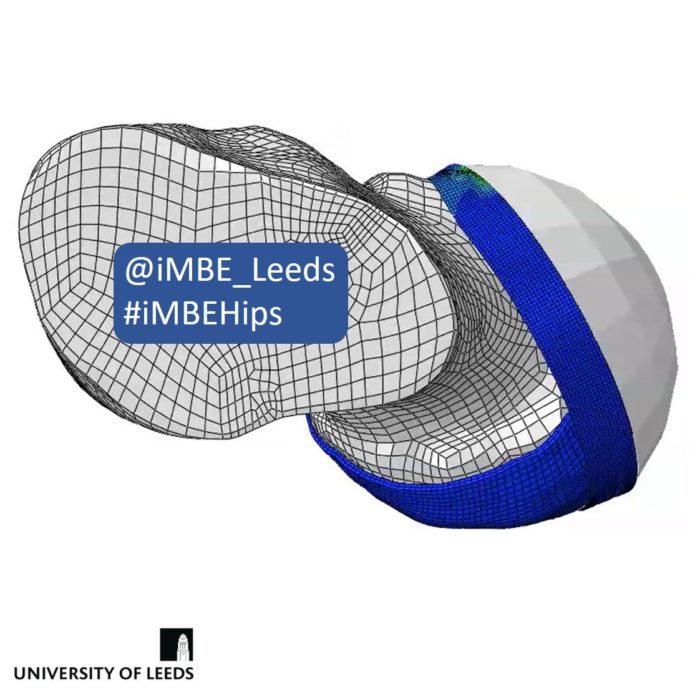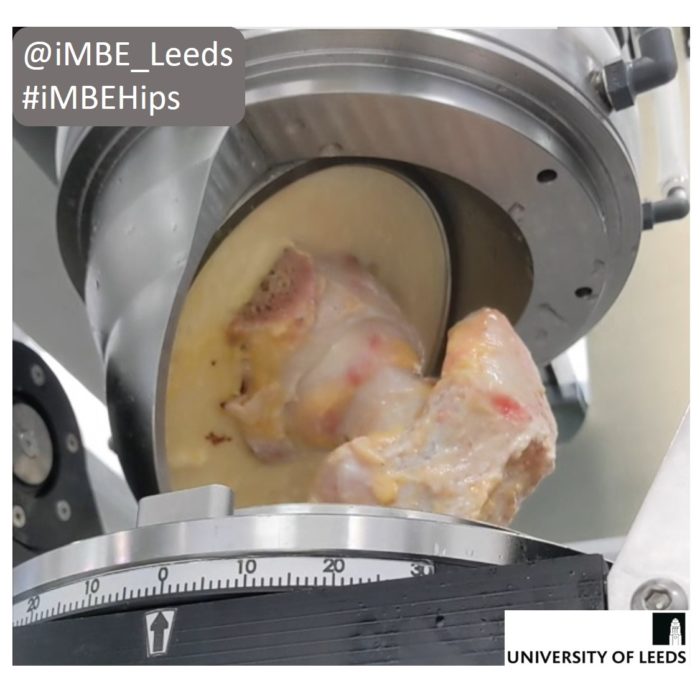Hip
 Hip osteoarthritis (OA) causes debilitating pain and function loss with over 60 million patients worldwide effected. The end-stage treatment remains total hip replacement surgery, and increasing numbers of patients require this. Hip replacement surgery is highly successful, however, the ageing active population and increasing levels of obesity are increasing the demands on hip replacements, consequently the number of revision procedures are increasing.
Hip osteoarthritis (OA) causes debilitating pain and function loss with over 60 million patients worldwide effected. The end-stage treatment remains total hip replacement surgery, and increasing numbers of patients require this. Hip replacement surgery is highly successful, however, the ageing active population and increasing levels of obesity are increasing the demands on hip replacements, consequently the number of revision procedures are increasing.
Total hip replacement: device design and testing
Predominant causes of total hip replacement relate to early mechanical failure, and wear and fatigue of the components over time.
 Research at the iMBE focusing on the effect of implant design uses techniques that encompass many aspects of the analysis of total hip replacement performance, including:
Research at the iMBE focusing on the effect of implant design uses techniques that encompass many aspects of the analysis of total hip replacement performance, including:
- Gait-cycle wear testing using both concentric ISO standard conditions and adverse conditions;
- Understanding the in vivo service conditions of implants through the analysis of explanted devices, and overcoming the complexity of measuring in vivo damage;
- Modelling to predict the wear behaviour under long term testing.
- Isolation and characterisation of wear particles from the bearing surface materials, for example, utilising density gradient centrifugation (sodium polytungstate) for isolation of very low volumes of metal and ceramic particles;
- Determination of the biological impact of wear particles.
If you'd like to hear more, please contact:
Total hip replacement: surgical variables
The likelihood of failure increases if the components are not well aligned relative to each other, and the biomechanical loading axis. The effects of surgical variation are investigated and increasingly incorporated into the pre-clinical testing methods.
- Novel gait-cycle wear tests under adverse conditions, such as edge loading due to mal-alignment of the joint centres;
- Development of short term tests that characterise the effects of surgical variables on early mechanical failure;
- Dynamic finite element model are developed to provide rich data in parallel with physical simulations of dynamically separating joint conditions;
- Rapid, mathematical techniques are under development to allow designers to take into consideration a variety of surgical outcomes at an early stage.
If you'd like to hear more, please contact:
Total hip replacement: patient variables
An important consideration in the success of a hip replacement is the individual patient. The rate of failure of the device through wear and loosening is affected by an individual’s activity patterns as well as the stiffness of the soft tissues around their hip joint. The reaction of the body to the wear particles which detach from the articulating surfaces varies from person to person. In addition, revision surgery may be needed due to painful impingement (either bone-on-bone or device-on-device) and risk of dislocation.
Mathematical tools are under development to rapidly evaluate activity data from a large number of individual subjects in order to establish targets for the new generation of adverse condition wear and damage tests. This activity is core to stratification of hip patients.
Additionally, experimental simulations are being developed that consider the effects of different bone geometries and soft tissue tension in patients.
If you'd like to hear more, please contact:
Natural hip disease models and tissue sparing procedure testing
Degeneration or damage of the hip joint in younger people requires approaches that aim to preserve the native joint tissues for as long as possible. Examples include femoroacetabular impingement, where abutments of the pelvic and femoral bones cause progressive soft tissue damage, and avascular necrosis, where limited blood supply causes bone changes and a risk of femoral head collapse.
Work on femoroacetabular impingement has included methods to replicate in vivo soft tissue damage indicators within in vitro and in silico environments. An in vitro natural joint simulation system has been developed, which is capable of applying multiple gait cycles under impingement-like conditions, allowing assessment of progressive tissue damage. Parametrised hip geometry and population data has been used to create computational models capable of showing trends in impingement incidence, depth and soft tissue strain in affected areas. 
On-going work to develop and validate these methods will create a system for pre-clinical testing of early stage interventions for the hip joint.
Natural joint in vitro and in silico models have also been used to assess hemi-arthroplasty designs where a replaced head articulates against the natural acetabulum.

If you'd like to hear more, please contact:
